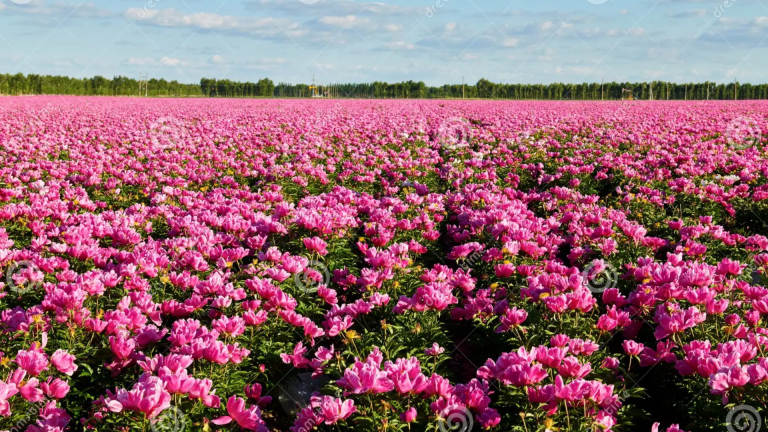Peony fields are wide open spaces filled with colorful, blooming peonies. This article will explain what peonies are, why people grow them in fields, and what makes them so special.
If you’re thinking of visiting, starting a garden, or enjoying flowers, you’ll find answers here. We’ll keep things simple and clear. No hype. Just helpful info. This guide offers real facts in plain language.
A peony is a plant known for its big, bright flowers and sweet scent. They bloom in spring or early summer in shades of pink, red, white, and yellow. A peony field is a large area where many peonies are grown together, often on farms or in gardens.
Peonies have been grown for centuries. People love them for their beauty, their fragrance, and the joy they bring. Some even see them as symbols of love and happiness. That’s why peony fields are worth knowing about.
What Is a Peony Field?

A peony is a flowering plant known for its large, soft blooms. These flowers are available in a variety of colors, including pink, white, red, and yellow. Some peonies have a sweet smell, while others have no scent at all.
They typically bloom in late spring or early summer and can live for many years, sometimes exceeding 70. The peony field is a large open area filled with rows of blooming peony plants. When the flowers are in full bloom, the field becomes a bright and colorful place.
These fields are often found on flower farms, in gardens, and parks. People visit to enjoy the flowers, take pictures, or relax in nature.
Peonies are becoming more popular. The climate and soil in some parts are good for growing them. Local gardeners and farmers have started planting small peony gardens.
These gardens are not just pleasing—they can also attract visitors, photographers, and flower enthusiasts. During the blooming season, the peonies may be used for weddings, festivals, or home decoration.
Types of Peonies
Peonies come in several different types, each with its unique growth and blooming characteristics.
The three main types are herbaceous, tree, and intersectional (Itoh) peonies.
Knowing the difference can help you select the most suitable one for your garden. Each one has its own strengths, growth habits, and bloom times.
Herbaceous Peonies

Herbaceous peonies are the most common type found in gardens. These plants die back to the ground every winter, then grow again in the spring.
They need cold weather to bloom well. Since they grow from the roots each year, they’re easy to care for and fit well in most garden spaces.
Tree Peonies

Tree peonies have woody stems that remain above ground throughout the year. Unlike herbaceous types, they do not die back in winter.
They bloom earlier in the season and produce large, eye-catching flowers. Their stems should not be cut down after blooming, as they are part of the plant’s structure.
Intersectional (Itoh) Peonies

Itoh peonies are hybrids that combine the traits of both herbaceous and tree peonies. They have strong stems that support their large blooms without additional support.
These flowers last longer and bloom in a wider range of colors. Itoh peonies are a great choice for those seeking low-maintenance plants with stunning flowers.
Popular Varieties

Some well-known peonies include Sarah Bernhardt, which has large, pink, and fragrant flowers. Coral Charm offers salmon-pink blooms that can change color as they open.
Bartzella is a yellow Itoh peony known for its strong stems and bright color. Each variety adds its beauty to the garden.
Planting Peonies
Planting peonies the right way gives you a strong, long-lasting plant. They’re slow to settle in, but worth the wait. Once established, they can bloom every spring for decades.
1. When to Plant
The best time to plant peonies is in fall, between late September and early November. Cool weather and damp soil in fall create the best start for your peony.
- Fall planting is best: Fall gives the roots time to grow before the ground freezes. The plant settles in better during cool weather.
- Winter rest builds strength: The plant rests through winter. In spring, it grows back stronger and healthier.
- Spring planting is not ideal: Early spring planting is possible. The plant may live, but it might not bloom the first year.
- Avoid extreme weather: Don’t plant in hot summer or when the ground is frozen. These conditions make it harder for roots to grow.
2. How to Plant
Peonies are long-living, low-maintenance plants—but only if planted the right way. They don’t like being moved, so take your time and get it right the first time. Here is a guide on how to plant peonies correctly.
- Dig a hole: Make it about 12 to 18 inches deep and wide. This gives the roots space to spread. Remove rocks, roots, and weeds from the hole. If the soil is heavy or clay-like, mix in compost to loosen it. Good drainage is important.
- Position the root: Place the peony root in the hole with the buds (eyes) facing up. The buds should be only 1 to 2 inches below the soil surface. If planted too deep, the plant may grow leaves but not flowers. If planted too shallow, the root may dry out or freeze in winter.
- Backfill and water: Fill the hole gently with soil. Gently press the soil to remove air pockets. Water deeply right after planting. This helps the soil settle around the root.
3. Spacing
Peonies like space and airflow. Don’t plant them too close to fences or walls. Allow air to move freely around the plant.
- Spacing between plants: 3 to 4 feet apart
- Why it matters: Air movement helps prevent mold and disease
- Bonus: Gives plants room to grow wide without crowding each other
4. Where to Plant
Select a well-lit, open area with fertile soil. If your soil remains wet, consider raising the planting area or building a mound to improve drainage.
- Sunlight: At least 6 hours of direct sun each day
- Partial shade: Okay in hot places, but not too much
- Soil: Well-drained and rich in organic matter
- Avoid: Low areas where water pools after rain
- Good locations: Along fences (with space), open beds, or near walkways
- Bad locations: Shady corners, soggy patches, or tight spots with little airflow
5. First-Year Watering
Water deeply right after planting. After that, water only when the top 2 inches of soil feel dry. Stick to deep, slow watering at the base of the plant.
- Don’t overwater: Peony roots can rot in soggy soil
- Watch rainfall: In rainy areas, you may not need to water often
- Avoid overhead watering: Wet leaves can lead to disease
6. Common Planting Mistakes
Address these issues promptly to prevent years of subpar growth or no blooms. Peonies are tough, but a few small mistakes can stop them from blooming:
- Planting too deep: Buds must be close to the surface
- Too much shade: Not enough sun = no flowers
- Poor drainage: Roots rot in wet soil
- Moving them too often: Peonies don’t like being disturbed
Ideal Conditions for Growing Peonies
Peonies are robust, long-lived plants, but they require the perfect environment to thrive. If you meet their basic needs, sunlight, soil, and climate. They’ll reward you with big, healthy blooms for many years.
Sunlight
Peonies require ample sunlight to produce large, vibrant flowers. In cooler regions, full sun all day is best. In warmer zones, a bit of afternoon shade can prevent heat stress. Avoid planting peonies under trees or against shady walls.
- Best choice: Full sun for 6 to 8 hours a day
- Acceptable: Light shade in the afternoon, especially in hot areas
- Risk: Less than 4 hours of sun can lead to weak stems and few flowers
Soil
Good soil is key to a healthy peony. Peonies don’t like wet feet. Too much moisture can cause root rot, especially in winter.
- Texture: Soil should be loose, well-drained, and fertile.
- Drainage: Water should flow through easily, with no pooling or soggy spots.
- pH level: Neutral to slightly acidic, between 6.5 and 7.0.
- Nutrients: Add compost or aged manure to enrich the soil.
- If your soil is clay-heavy: Mix in sand or compost to loosen it.
- If your soil is too sandy: Add organic matter to help it retain moisture.
- If the pH is off: Test your soil. Use lime to raise pH or sulfur to lower it.
Climate
In tropical or very warm areas, peonies can be tricky. If your winters are mild, try planting in the coolest part of your yard.
Some gardeners in warm climates chill roots in the fridge before planting, but results vary. Peonies are cold-weather plants at heart.
- Peonies need a chilling period in winter to rest: Cold weather helps them go dormant and recharge for spring. This resting phase is key for healthy blooming.
- Without cold, they may grow leaves but won’t bloom: Warm climates may support leaf growth but not flowers. The plant needs winter chill to form flower buds.
- USDA zones 3 to 8 are best: These zones offer the cold winters peonies need. Peonies grow and bloom naturally in these areas.
- In warmer zones, choose low-chill or Itoh varieties for better success: These types can handle milder winters and still flower. They’re ideal for gardeners in zones 9 and up.
Caring for Peonies
Peonies don’t require a lot of work, but a few small tasks throughout the year can make a significant difference.
Caring for them properly helps prevent disease, boosts blooms, and keeps plants healthy for decades. These steps take little time but help your plant stay strong through every stage.
- Watering: Peonies need consistent moisture, especially in dry weather. Water when the top 2 inches of soil feel dry. Always water at the base—wet leaves can lead to the growth of mold and mildew.
- Fertilizing: Peonies grow better with a little feeding in spring and after bloom. Use a balanced fertilizer. Apply it when new shoots appear, spreading it around the root zone. Don’t overfeed—too much nitrogen can cause lots of leaves and few flowers.
- Mulching: Mulch protects roots and helps hold in soil moisture. In late fall, add a thin layer of straw, bark, or compost. Keep it a few inches away from the crown to prevent rot. Mulch also stops weeds and shields the roots from cold snaps.
- Pruning: Cut back herbaceous peonies in late fall after the leaves turn brown. Trim all stems to the ground and clear dead leaves to prevent disease. Tree peonies should not be cut down—remove dead or broken branches.
Common Pests and Problems
Peonies are resilient plants, but they can still encounter a few issues. Ants are often seen on peony buds, but they don’t harm the plant—they’re just attracted to the sweet nectar on the buds and usually leave once the flowers open.
Peonies are more susceptible to fungal diseases, such as leaf spot or botrytis blight, particularly in damp or crowded conditions.
To prevent this, provide your plants with space for air circulation, avoid watering the leaves, and remove any affected foliage promptly. Cleaning up dead leaves in the fall also helps prevent disease from returning.
When and Where to Visit Peony Fields
The best time to visit peony fields is from late spring to early summer, usually between May and June. This is when the flowers are in full bloom. The exact timing depends on local weather, so let’s explore some of the best places to visit the peony fields.
1. Peony Garden, Brooklyn Botanic Garden, USA

Located in New York, this garden boasts a diverse array of peonies in a serene setting. Visitors can see both herbaceous and tree peonies during bloom season. The best time to visit is in May when flowers are at their peak. The garden also offers walking paths and quiet spots perfect for relaxing or taking photos.
2. Lao Tzu Peony Garden, China

This garden is also refer as “City of Peonies” and is famous for its annual Peony Festival held every April. This garden offers stunning views of rare and classic peony varieties. It’s a cultural site that blends flowers with Chinese history and design. Ideal for a spring visit during April and early May.
3. Luoyang, Henan Province, China

Luoyang is known as the “City of Peonies” and hosts a famous flower festival. The city is home to large peony gardens and over a thousand varieties. Peak bloom happens in mid-April during the Luoyang Peony Festival. Visitors from around the world come to enjoy cultural performances, traditional displays, and the breathtaking floral scenery.
4. Hokkaido University Botanical Gardens, Japan

These gardens in northern Japan have a cool climate that suits peonies well. It is the second oldest botanical gardens in Japan and serve both educational and recreational purposes. They feature Japanese and Western peony varieties in a quiet natural setting. Best visited in late May to early June.
5. Brooks Gardens, Oregon, USA

Located in the Willamette Valley, this farm grows hundreds of peony types and a vast collection of historic bearded irises. Visitors can walk through fields, shop for plants, or take photos. Bloom time is usually from mid-May to mid-June. The farm also hosts seasonal events and workshops, making it a popular destination for garden lovers.
Conclusion
Peony fields are a stunning reminder of how beautiful nature can be. Walking through rows of blooming flowers is calming and memorable. The soft petals, bright colors, and gentle scent make peonies a favorite for many.
These flowers don’t just look good in fields—they can also thrive in home gardens with the right care. Peonies need full sun, well-drained soil, and a cold winter to rest. Once planted properly, they come back every spring, stronger and fuller each year.
With a little patience, they can live for decades. Whether you’re visiting a public field or planting peonies in your yard, they bring a special kind of joy. They are simple, long-lasting, and beautiful—perfect for anyone who loves flowers and quiet moments outdoors.













